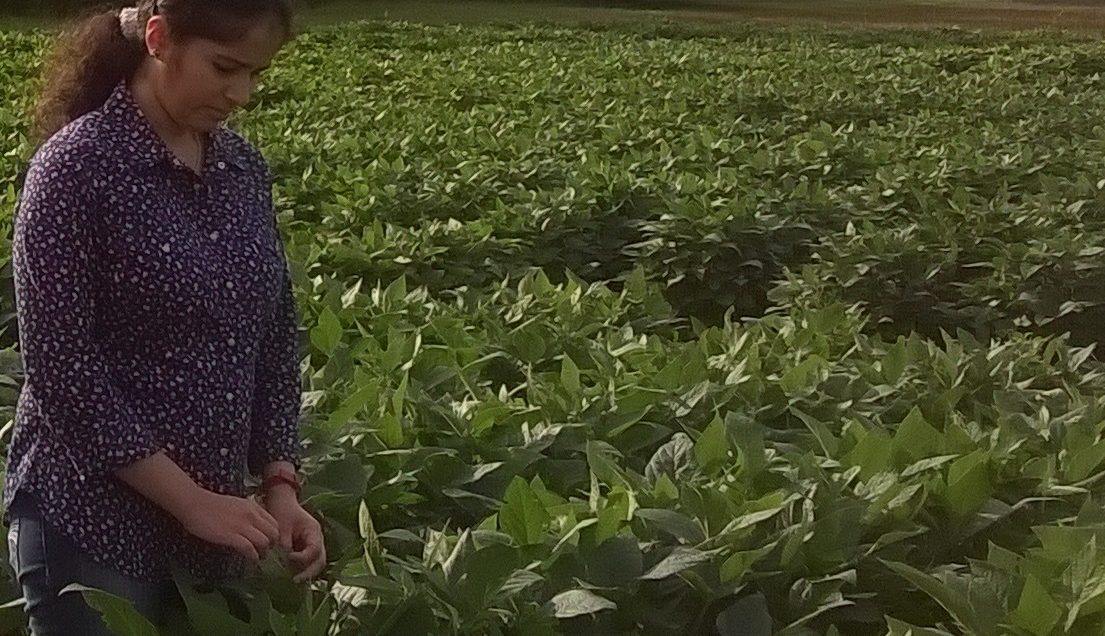CLEMSON – Sweltering temperatures and low-moisture conditions can have a large impact on South Carolina soybeans, causing farmers to turn away from one of the state’s highest-yielding crops.

But, some Clemson researchers are studying how to develop soybean varieties that can germinate and grow under drought conditions.
Sruthi Narayanan, an assistant professor of crop science in the university’s Plant and Environmental Sciences Department and Ben Fallen, leader of the Clemson soybean breeding program at the Pee Dee Research and Education Center, are looking at relationships between seed viability, germination rates and soil moisture in an effort to breed for soybeans that are drought-tolerant. Their initial findings are published in an article in the March 2019 edition of the journal Agronomy.
“Drought is a major environmental factor that limits soybean yield in the southeastern United States,” Narayanan said. “Drought often occurs during soybean planting time in South Carolina. For many years, producers have planted soybean seeds in dry soil, hoping that it would rain and ensure emergence. Often, we would have a prolonged drought which resulted in poor emergence leading to replanting, which caused significant financial burden. The goal of our study is to develop early-season drought-tolerant soybean varieties.”
Soybeans typically are planted in South Carolina from May 10 to July 11 and harvested from Oct. 20 to Dec. 30. They require a soil temperature of about 54 degrees to germinate. Soil temperatures typically are higher than air temperatures during summer months. Climate data shows the average air temperature from May to July in South Carolina is 89 degrees. According to the Environmental Protection Agency, South Carolina temperatures have warmed by one-half to one degree in the last century, making South Carolina prone to droughts.
“One of the biggest germination issues, aside from seed quality, is soil moisture,” Fallen said. “If there is not enough moisture, seeds have a hard time germinating. Or if there is just enough moisture for the seed to swell, but not complete the germination process, the seed will more than likely not recover.”
Narayanan and Fallen want to know what happens when soybean plants are exposed to drought conditions. This study is part of a larger effort by Clemson’s College of Agriculture, Forestry and Life Sciences to create crop varieties optimized for Southeastern growing conditions.
“Having a seed that can germinate under low moisture conditions could eliminate or reduce any issues with partial germination under limited moisture conditions,” Fallen said.
Preventative seed treatments or methods farmers or seed companies can use to help insure good stands are available. However, there are little to no options available to help with limited moisture at planting. Irrigation could help in low-moisture situations but irrigation can be environmentally and economically costly.
“But fewer than 20 percent of soybean acres in South Carolina are irrigated,” Narayanan said. “Our study is aimed at improving the capabilities of soybean plants to withstand drought conditions.”
The study is looking at traits such as seed weight and primary root length. For germination to begin, each seed must absorb water at least 50 percent of its weight. More water is needed for emergence.
Long primary roots help reach deeper soil layers where water is available and can improve emergence when soil moisture levels are low. The study found long primary roots play an important role in ensuring the plant has enough water to emerge and grow.
Determining the roles seed weight and primary root length play in helping soybeans become drought-tolerant is just the beginning. Narayanan and Fallen said they still have a way to go before drought-tolerant soybeans are planted.
Clemson’s Pee Dee Research and Education Center near Florence – home to the university’s soybean breeding program – uses high-tech labs to speed up the plant breeding process, but incorporating a specific trait into a line can take many years, Fallen said. “The reason being there are several traits that are needed to be incorporated. So, a lot of time and effort goes into developing new varieties. But, we’ve taken the first step and that is to identify traits of interest that can be used to combat or solve a problem such as drought tolerance.”
Soybeans are important for the South Carolina economy. Figures from the United States Department of Agriculture’s National Agricultural Statistics Service shows 375,000 harvested acres of soybeans produced more than 11 million bushels for a total of $99,014,000 in South Carolina in 2018. These numbers may be lower for 2019.
“Some local farmers I have talked to stopped planting soybeans because of limited moisture availability,” Fallen said. “Now it is too wet to plant in many areas of the state. That’s why we’re conducting this study. It’s important for South Carolina farmers to be able to plant whenever possible because you never know when things will go from bad to worse.”
In a related study, Narayanan’s master’s student Harrison Fried from Baltimore looked at the ability of soybean roots to penetrate hardpan soil as a way to help with drought tolerance. The goal is to someday create plants with roots that extend deeper into the ground, making them more drought-tolerant and nutrient-efficient.
-END-
Get in touch and we will connect you with the author or another expert.
Or email us at news@clemson.edu

